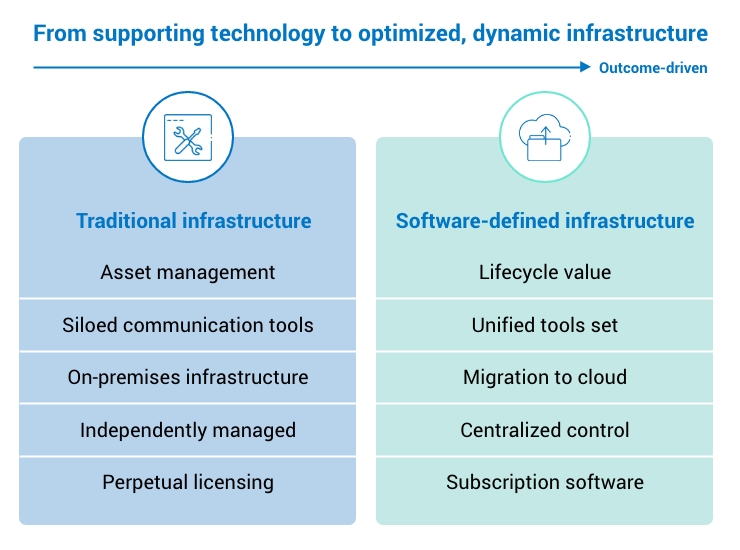-
Featured services
2026 Global AI Report: A Playbook for AI Leaders
Why AI strategy is your business strategy: The acceleration toward an AI-native state. Explore executive insights from AI leaders.
Access the playbook -
Services
View all services and productsLeverage our capabilities to accelerate your business transformation.
-
Services
Network Services
-
Services
Cloud
-
Services
Consulting
-
-
Services
Data and Artificial Intelligence
- AI and Intelligent Solutions
- Data/AI Strategy and Program
- Data Engineering and Platforms
- Data Governance and Management
- Data Visualization and Business Decision
- GenAI Consulting
- GenAI Platforms
- GenAI Industry Services
- GenAI Infrastructure Services
- GenAI Value Transformation
- View Data and Artificial Intelligence
-
Services
Infrastructure Solutions
-
Services
Global Data Centers
-
Services
CX and Digital Products
-
Services
Application Services
-
Services
Sustainability Services
-
Services
Digital Workplace
-
Services
Business Process Services
-
Services
Generative AI
-
Services
Cybersecurity
-
Services
Enterprise Application Platforms
![]()
Accelerate outcomes with agentic AI
Optimize workflows and get results with NTT DATA's Smart AI AgentTM Ecosystem
Create your roadmap -
-
-
Insights
Recent Insights
-
The Future of Networking in 2025 and Beyond
-
Using the cloud to cut costs needs the right approach
When organizations focus on transformation, a move to the cloud can deliver cost savings – but they often need expert advice to help them along their journey
-
Make zero trust security work for your organization
Make zero trust security work for your organization across hybrid work environments.
-
-
![]()
2026 Global AI Report: A Playbook for AI Leaders
Why AI strategy is your business strategy: The acceleration toward an AI-native state. Explore executive insights from AI leaders.
Access the playbook -
-
2026 Global AI Report: A Playbook for AI Leaders
Why AI strategy is your business strategy: The acceleration toward an AI-native state. Explore executive insights from AI leaders.
Access the playbook -
Discover how we accelerate your business transformation
-
About us
CLIENT STORIES
-
Liantis
Over time, Liantis – an established HR company in Belgium – had built up data islands and isolated solutions as part of their legacy system.
-
Randstad
We ensured that Randstad’s migration to Genesys Cloud CX had no impact on availability, ensuring an exceptional user experience for clients and talent.
-
-
CLIENT STORIES
-
Liantis
Over time, Liantis – an established HR company in Belgium – had built up data islands and isolated solutions as part of their legacy system.
-
Randstad
We ensured that Randstad’s migration to Genesys Cloud CX had no impact on availability, ensuring an exceptional user experience for clients and talent.
-
![]()
2026 Global AI Report: A Playbook for AI Leaders
Why AI strategy is your business strategy: The acceleration toward an AI-native state. Explore executive insights from AI leaders.
Access the playbook -
- Careers
Topics in this article
Simply put, software-defined infrastructure (SDI) is about using software to control and drive hardware.
Because cloud-based workloads demand greater availability, scale and performance across your organization’s infrastructure, the traditional hub-and-spoke model – with core data centers and applications linked to branches, warehouses, logistics operations and more – is giving way to SDI. Hardware now remains on-premises while the management platform or controller that drives change, delivers simplicity and enables agility is based in the cloud.
Increasingly, software controls both on-premises and cloud networking architecture, using APIs, AI and advanced analytics to deliver agility and availability along with centralized orchestration and standardization to enforce policies and governance.
SDI controllers or cloud-based management platforms simplify and consolidate operational management, while centralized control mitigates the risk of human error and provides greater visibility of what’s happening across your infrastructure.
Why organizations are transitioning to SDI
The drivers for deploying SDI include improving business agility by responding to changes in a timely manner, enabling faster and more reliable application and service deployment, and improving the efficiency of IT operations.
With SDI, you can use orchestration and standardization to drive initial device configuration and ensure consistent policy-based provisioning. You can also better manage the availability and security of your infrastructure day to day: API-level integrations generate advanced analytics used for predictive insights, including proactive security notifications.
In short, by deploying SDI, you gain the benefits of a cloud-ready infrastructure with the scalability, performance and resilience you need to support secure, high-quality user and customer experiences.
However, managing the transition from hardware-centric to SDI is critical to a successful digital transformation. The shift adds complexity to software asset management and can negatively affect lifecycle value and return on investment (ROI) if licensing is not well managed.
Organizations may also have the added complexity of operating hybrid infrastructures with a mix of legacy and software-defined assets while still supporting application availability and business continuity. This mix of technologies requires a new approach to IT operations.
How SDI compares with the traditional approach
The change in emphasis from traditional hardware to dynamic, software-driven infrastructure control is summarized as follows:
We have seen this transition in our own support services, which have underpinned asset availability for multivendor hardware for more than 30 years. Now, we have extended this capability with lifecycle services to optimize the performance and ROI in software-driven infrastructure hardware.
Our Services Platform aggregates multiple data sources to provide one source of insight, making it simpler and less risky to manage multiple license types along with associated and legacy hardware. As a result, our clients gain visibility and control that simplifies operational support through data-driven insights for improved technology adoption and software lifecycle value.
Traditionally, infrastructure management has relied on manual processes. Hardware components such as networking, data centers and security devices have required physical, on-premises configuration and maintenance. Also, IT teams need specialized knowledge to manage and maintain a variety of complex and increasingly outdated kit.
Given that each piece of hardware has to be set up and configured separately, it’s a time-consuming and – given human fallibility – error-prone process.
5 main benefits of SDI
Here are five ways in which SDI can benefit your organization:
- Scalability: Want to expand or contract your infrastructure? You’ll find SDI more easily scalable and agile than traditional hardware. The ability to remotely provision and configure new technologies is ideal when you need to adapt to dynamic business demands.
- Speed: A software-defined approach also enables the automation of operational processes. You’ll benefit from efficiency in terms of both initial deployment and provisioning, and you’ll be able to ensure software version compliance and enforce infrastructure policies centrally.
- Simplification: Managing multiple technologies becomes less complex when you use APIs to gain the benefits of advanced analytics. This is the approach we’ve taken with our Services Portal, to help our clients manage their multitechnology, multivendor infrastructures.
- Spending: Functionality is one thing; finance is another. In our experience, consolidating subscription software investments into Enterprise Agreements typically realizes savings of more than 30% for our clients. Also, insights into license management insights lessen your financial risk of noncompliance while ensuring efficient usage and giving full visibility of license entitlements.
- Security: Any system is only as good as its weakest link. SDI can be considered more secure than legacy hardware because of its ability to harness data, centralized control and platform automation to reduce the risk of human error. Then, advanced analytics, predictive insights and security notifications make proactive intervention easier and faster.
SDI and automation
As noted, automation plays a key role in the success of your SDI. It allows you to use orchestration and standardization tools to streamline and simplify your infrastructure management processes.
Apart from the initial configuration and deployment of machines and applications, you can also automatically monitor your infrastructure’s performance and ability to support business continuity. Predictive insights and security notifications will enable you to deal proactively with current or potential issues.
You also benefit in other ways – from automated backups and data recovery, for example, and from better security and disaster-planning functionality.
These aspects can all be managed in-house or with the help of an SDI service provider.
SDI works for on-premises and cloud
SDI is an essential part of a successful cloud-first strategy because it gives you the agility and scalability required to support cloud-based workloads and provide application availability to all users, regardless of their location or device.
Software-defined data center technologies – include storage and computing – underpin private- and public-cloud environments. Whether you’re following a single-, hybrid- or multicloud approach, the technology still needs to be software-driven to deliver the full value of cloud.
Network services have also been transformed by software-defined technologies. With the capability to virtualize network functions such as security and IP addressing, the managed software-defined wide-area network (SD-WAN) delivers the end-to-end connectivity and application delivery essential to the success of digital business strategies.
At NTT, our resources and services support the infrastructure modernization ambitions of clients across geographies and sectors. We can design and deploy technology solutions from the edge to the cloud to maximize the value of legacy assets and accelerate the time to value for new software-defined investments.
Depending on your business strategy and your in-house capabilities, you can choose between a fully managed service or supported infrastructure.
Avoiding pain before the gain
When you modernize with SDI, you can gain a more agile, flexible approach to managing your environment. You can also reduce costs, complexity and risk.
However, the journey from traditional to software-defined infrastructure can create new challenges – starting with how you choose to migrate and the technologies you will use.
This challenge can be heightened by expectations within your organization. You may be asked to deliver more business value and an improved ROI quicker than you’d expect, while at the same time dealing with a raft of ever-changing business requirements and face a shortage of technical skills to achieve your goals.
SDI services offer visibility, control and faster time to value
The most crucial aspect of SDI is the visibility and control it brings. In this regard, SDI services can provide a range of benefits, from supporting asset availability to dynamic and ongoing infrastructure optimization.
If you wish, you can implement SDI services on-premises. This will allow you to create and manage your own software-defined technologies and give you greater control and flexibility in terms of your infrastructure and operational resources.
And, should your organization wish to retain operational control of all or some of their infrastructure, an experienced systems integration and services partner like NTT can help you navigate these challenges confidently and speedily.
Our Software-defined Infrastructure Services give our clients access to the innovation and expertise essential to achieving the “next-level” management of their software-defined infrastructure, as well as the visibility and control to inform their decisions from procurement to governance.
To harness the power of this data, our clients have access to our Services Portal, which presents insights into the availability and lifecycle status of their hardware and software. It’s also fully configurable, and can be set up to give information , such as infrastructure insights and risk summaries, predictive insights and vulnerability notifications.
They can also stay fully up to speed on everything from technology adoption to asset availability and – via our Digital Wallet – streamline their software asset management with multivendor license lifecycle insights.
We also provide quarterly recommendations, based on expert analyses of advanced analytics, on how to accelerate technology adoption, improve security and asset availability, and make continuous ROI improvements to ensure efficient usage and procurement practices.
With near-real-time insights across your hardware and software assets, combined with our experts’ quarterly recommendations, you’ll be well placed to achieve faster time to value, control costs and improve ROI.





